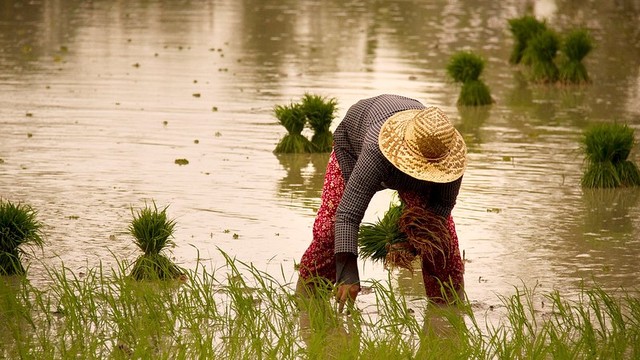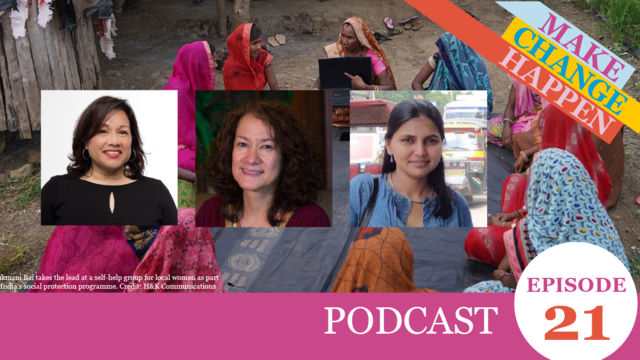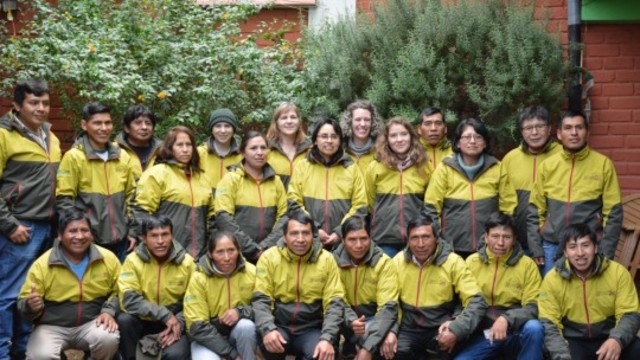Learning to value Mother Earth
Making informed choices about eating foods that have less of an environmental impact is increasingly important. We can all learn lessons from local communities living in the Andes.

Peruvian men and women on a mountainside, pouring water on the earth
Our Holy Earth lives, only she does not talk.
The interviews below came from a series of 'wisdom dialogues' that were part of an IIED project in Peru. Farmers from the Quechua and Aymara communities in Peru shared their traditional knowledge and insights with researchers and scientists.
Respecting the earth
 Antonio Pineda has learned many things in his life. He knows when to plant his crops on the Altiplano high up in the Andes. In fact he grows them so successfully that he wins awards for the wide variety of potato varieties that he cultivates. He also herds llamas, using the llama wool for making clothing, rope and twine. But he never forgets where all the bounty that his family lives on comes from.
Antonio Pineda has learned many things in his life. He knows when to plant his crops on the Altiplano high up in the Andes. In fact he grows them so successfully that he wins awards for the wide variety of potato varieties that he cultivates. He also herds llamas, using the llama wool for making clothing, rope and twine. But he never forgets where all the bounty that his family lives on comes from.
“Our Holy Earth lives, only she does not talk”, says Antonio. As a result, he and other farmers living in the village of Aymaña cultivate the land with manure and follow rituals “so we do not destroy Mother Earth”.
For Antonio, and many Aymara and Quechua communities living in Bolivia and Peru, Pacamama, or Mother Earth, is bountiful year after year, because of the devotion and respect she receives from farmers.
Sometimes she provides her own blood – rock salt (puka cachi) – and other times she offers clayish soil (chajo), which is high in mineral content that is good for nourishing the plants.
This is why Antonio makes offerings to Pacamama and other spirits, such as Apus, the spirits of mountains, rivers or lakes.
Food comes from the Earth and should be respected, and this is why he thinks the storage room where his food is stored should be entered barefoot and perfumed with incense.
Imagining the future
 A traditional Altiplano custom of remembering, imagining and dreaming to influence outcomes in the future – called alasitas – was used during the IIED project to encourage community members to “dream”: about how they saw food production and agricultural research in the future on their farms and in their local communities.
A traditional Altiplano custom of remembering, imagining and dreaming to influence outcomes in the future – called alasitas – was used during the IIED project to encourage community members to “dream”: about how they saw food production and agricultural research in the future on their farms and in their local communities.
Presentación Velásquez, a farmer, shares her 'dream' in the video below. She shows us around a model of her fields and house to demonstrate how she grows and prepares her food by – for instance by grinding the quinoa with a ‘qola’ or stone mill.
She is proud that she is self-sufficient in producing her family’s food from her garden, hens and guinea pigs and her garden. “All the food comes from my fields, I do not go to the market to buy anything,” says Presentación.
Sharing traditional knowledge
The dialogues between scientists and citizens, referred to as the ‘Wisdom Dialogues’, led to a confirmation of how rich and detailed is the traditional knowledge held by indigenous communities. This detailed knowledge is shared below in this video with Lydia Faggione and Andrés Ramos who speak of the signs or indicators 'important for our fields', such as how plants are growing or the size and shape of animal droppings. They watch these signs to know how and when to plant crops, and how they will fare.
Antonio Pineda worries that this rich knowledge is not being passed on to future generations. He says the young people can’t read the signs – such as the call of the fox – for when it is right time to plant their crops. “Even the grown-ups have forgotten the potato names,” he says. But, there is still hope: “Others want to follow, they want to recover the knowledge, and they ask.”
Collaboration and dialogue
The project aimed to foster greater dialogue between scientists/researchers and farmers, and for farmers to have a greater say in future agricultural research.
 Don Rufino Chambi, 63, who has been a farmer all his life, spoke at the meeting about his 'dream' of greater collaboration and dialogue between the scientists and farmers, where they become compañeros (companions or partners), sharing ideas. But the present model, as he describes it, is one where the scientists think they know best: “We know that the scientists of the agriculture ministry want to provide seeds, then they explain which fertiliser they use, that they want to donate, and we think no, they should not donate to us,” he says, because the potato varieties they are providing only last for two years, “and then the seeds will disappear”.
Don Rufino Chambi, 63, who has been a farmer all his life, spoke at the meeting about his 'dream' of greater collaboration and dialogue between the scientists and farmers, where they become compañeros (companions or partners), sharing ideas. But the present model, as he describes it, is one where the scientists think they know best: “We know that the scientists of the agriculture ministry want to provide seeds, then they explain which fertiliser they use, that they want to donate, and we think no, they should not donate to us,” he says, because the potato varieties they are providing only last for two years, “and then the seeds will disappear”.
In the video, he says he hopes the scientist will put his notebook down and talk to them. He says the families plant potatoes only after they produce their kintu (an offering of three coca leaves arranged in a fan shape) and wine. "We know how and when to plant by looking at [signs such as] the lily [a plant often planted close to people’s houses], the mountain ridges, moon and sun." He adds: “And the families are teaching the children how to cultivate.”
Putting farmers at the centre of decisions
Since 2007, IIED has been part of a global initiative to create spaces for farmers like these, and other citizens, to decide what type of agricultural research is needed. The aim is to put the individuals who produce, distribute and consume food at the centre of decisions on food systems and policies, rather than corporations and market institutions. This process was carried out as part of a project called Democratising the governance of food systems: citizens rethinking food and agricultural research for the public good.
Despite the reservations expressed by some participants, the project did develop a respect on both sides for the knowledge held by the indigenous communities and also by the scientists: “The sincere, attentive and mutual respect between the scientists and farmers when focusing on their knowledge differences was a pleasant surprise for both parties; this has set the terms of engagement for a common agenda in the future.” (pg 162, Voices and flavours from the Earth: visualising food sovereignty in the Andes (PDF)).
And it resulted in surprising and unplanned outcomes. For example, some members from Aymara and Quechua communities were surprised by the high number of male scientists, which suggested a lack of gender equality in terms of how knowledge was shared and held in the scientific community.
“They were surprised by the high number of male scientists, whereas in the communities most knowledge is shared between men and women, with the exception that women are the guardians of seeds and food storage. Wise men and women realise that their knowledge is not private property, it cannot be sold nor bought or stolen.”
One participant said: “We have learned from our wisdom. We have recalled how we were before, now we will not forget what we are and that is how we want to continue to be in the future.”
In the end the project reflects the rich and detailed knowledge held by the local communities and their worldview of the earth as a living, sacred Mother Earth, and of everything as interconnected. The food produced and the animals living off the land cannot survive without Pacamama, who needs to be protected and sustained through organic and non-mechanised farming practices.
“We would say [to the scientists] that we plough our fields with oxen, not with tractors,” says Don RufinoChambi. “We won’t use a tractor because the worms living in the soil will be thrown out and the birds will eat them and there is nobody to sustain Mother Earth. This is what we defend.”
Respect for the food they eat and devotion to Mother Earth, from where it comes, shines through the interviews. “Today the youngsters are running after money, only money... Will they eat the money?” asks Antonio Pineda. “The money will be piled up, just the same as the minerals. But we cannot eat this. We will eat the food from our fields and we will live with this food.”



